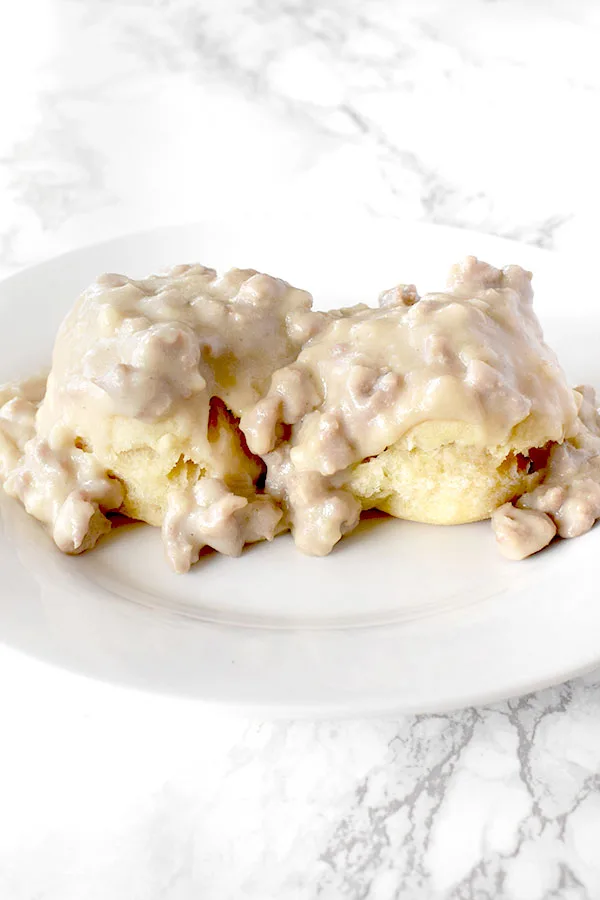This Dairy Free Sausage Gravy is made without milk and is perfect for Southern dishes like dairy free biscuits and gravy.

Sausage gravy is a traditional breakfast dish in the South.
Typically, it is served over biscuits or buttermilk biscuits.
Sausage gravy is usually made by first cooking the sausage, then removing the meat and using the fat to make a roux.
At this point, milk is usually added, but since this Sausage Gravy is made without milk, you can use either a dairy free milk or water.
If you don't have sausage, you can easily use ground beef instead.
What is the difference between country gravy and sausage gravy?
Unlike country gravy, sausage gravy is made with fat from the meat to make a roux and actually contains meat. Country gravy, on the other hand, typically uses butter to make the roux and is meatless.
Does sausage gravy have dairy?
Yes, sausage gravy contains dairy unless it is specifically a dairy free recipe, because it's made with milk.
However, you can make sausage gravy without milk. With the quality of dairy free milks on the market nowadays, it's likely you won't even taste a difference.
To make sausage gravy without milk, simply replace the milk with a dairy free milk or water.
Unsweetened almond milk (especially barista styled almond milk and almond cooking milk), natural flavored full fat oat milk, and soy milk all make great substitutes for milk.
Water is also a good substitute for milk in sausage gravy, though the color won't be as opaque as it would with a dairy free milk.
Personally, I like to use water and add some dairy free milk for color.
How do you make sausage gravy?
The first step to making sausage gravy is frying the sausage - I often use ground beef instead.
By doing this, you render the fat from the meat which you use to make a roux which will thicken the sauce.
You do this by adding flour and toasting it until it has a nutty flavor. If you stop cooking it too early, your gravy may have a flour taste to it.
Then, you add milk (or in this case, dairy free milk) which, with the help of the roux, becomes a sauce.
WHAT IS A ROUX?
A roux is equal parts flour and fat cooked together until it reaches a specific color.
It is used as a thickening agent for gravy, sauces, soups, and stews, and have been used in French cooking for hundreds of years to thicken sauce.
The flour is added to the melted fat or oil on the stove top, blended until smooth, and cooked to the desired color.
A roux can be white and used for white sauce, blond for classic gravies, or brown, which is used in gumbo and jambalaya.
The lighter the roux, the more thickening power it has.
Once the roux is the desired color, liquids like stock are added.
Browning Flour
People often see instructions like "brown the flour" and avoid this step because they aren't making brown gravy.
Browning flour means you're cooking the flour. This removes the flour flavor so it won't ruin the taste of your gravy.
WHY USE FLOUR TO THICKEN GRAVY
I use flour to thicken gravy because it gives the gravy that classic opaque, slightly pale look.
Many people don’t like using flour because if it isn’t cooked long enough, it can give a floury flavor to the gravy. Also, if not made properly, it can become clumpy.
The good news is, making a smooth creamy gravy is a snap if you turn it into a roux first.
Another benefit some people see with gravy made with flour is that it keeps better in the fridge. This means it can be made ahead of time or use up leftovers.
Which dairy free milk should I use?
Honestly, it's whatever you have on hand or prefer.
My go-to is a neutral flavored full fat oat milk because I find that they are the most similar to regular full fat milk.
Almond milk works well here, too. I personally like using an unsweetened barista almond milk because it is more similar to regular full fat milk, but whatever you have will work.
You can also use coconut milk, though it may have a subtle coconut flavor if you do. Coconut milk has more fat and is similar to using a light cream, but it won't make a noticeable difference.
I've never used soy milk, so I don't have any opinions on it, but you can use that as well.
IS KOSHER Meat BETTER?
Kosher animals are kept in better conditions than non-kosher animals due to strict kosher health requirements of the animals.
Also, the salting process used as part of the process of making meat kosher is similar to dry brining, and therefore produces a better quality meat.
While I’ve only eaten kosher meat and so I cannot compare, I’ve been told by non-Jews who do not keep kosher that they’ve noticed that kosher meat is of superior quality to cook with.
HOW TO DEFROST Meat
IN THE FRIDGE
Defrosting meat in the fridge is the most highly recommended.
To do this, place the frozen meat in a pan and let it thaw. Oftentimes when meat thaws, it releases liquids that can leak onto your fridge, so the pan is really helpful.
Meat typically takes a full day to thaw. Once thawed, it can remain in the refrigerator for a day or two before cooking.
IN COLD WATER
Defrosting meat in water should take two to three hours.
Submerge your sealed meat in a pot or bowl full of cold water. Change out the water every 30 minutes or so.
Do not use hot water because it can start cooking your meat.
Can you cook FROZEN meat?
According to the USDA, you can cook frozen meat. It will take 50% longer to cook, but it’s an option.
You should also cook it on a roasting rack or over vegetables so that the heat can circulate around the meat.
IS IT SAFE TO REFREEZE RAW meat?
According to the USDA, “food thawed in the refrigerator is safe to refreeze without cooking.” However, you do lose quality when refreezing previously defrosted meat.
Every time you defrost meat, it loses moisture as it thaws, which also leads to a loss in flavor. To compensate for this, marinate the meat to add more flavor and juice.
The USDA also says not to “refreeze any foods left outside the refrigerator longer than 2 hours; 1 hour in temperatures above 90°F.”
HOW TO STORE MEAT
Once cooled, place in an airtight container and refrigerate. Store for 3 to 4 days.
HOW TO FREEZE MEAT
Freeze leftovers within 3-4 days. Place in an airtight container or resealable freezer bag.
Freeze for up to 6 months. After that, it is still safe to eat but the quality begins to degrade.
How to Reheat
Gravy will thicken as it cools. When you reheat it, add dairy free milk or water until it is smooth and reaches your desired consistency again.
Sausage Gravy without Milk

This sausage gravy is made without milk and is the dairy free version of the classic Southern breakfast.
Ingredients
- 8 ounces sausage or ground beef
- ¼ cup flour
- 2 ½ cups dairy free milk
- Salt
- Pepper
Instructions
- Tear small pieces of sausage or ground beef and add them in a single layer to a large skillet or frying pan.
- Brown the sausage over medium-high heat, stirring frequently.
- Reduce the heat to medium-low and add the flour. Stir it around and cook it for another minute to make a roux.
- Pour in the milk, stirring constantly. Cook the gravy, stirring frequently, until it thickens.
- Add salt and pepper to taste.
Nutrition Information:
Yield:
6Serving Size:
1Amount Per Serving: Calories: 189Total Fat: 13gSaturated Fat: 5gTrans Fat: 0gUnsaturated Fat: 6gCholesterol: 31mgSodium: 463mgCarbohydrates: 10gFiber: 0gSugar: 0gProtein: 9g
Anna
Monday 31st of July 2023
Since you are kosher what kind of sausage do you use? I have never had biscuits and gravy made with beef, so I intend to try it. But I am curious about the sausage. Thanks and love your recipes.I
ElissaBeth
Friday 4th of August 2023
Since I always have ground beef around the house and rarely if ever do I have sausages, I tend to just use ground beef :)